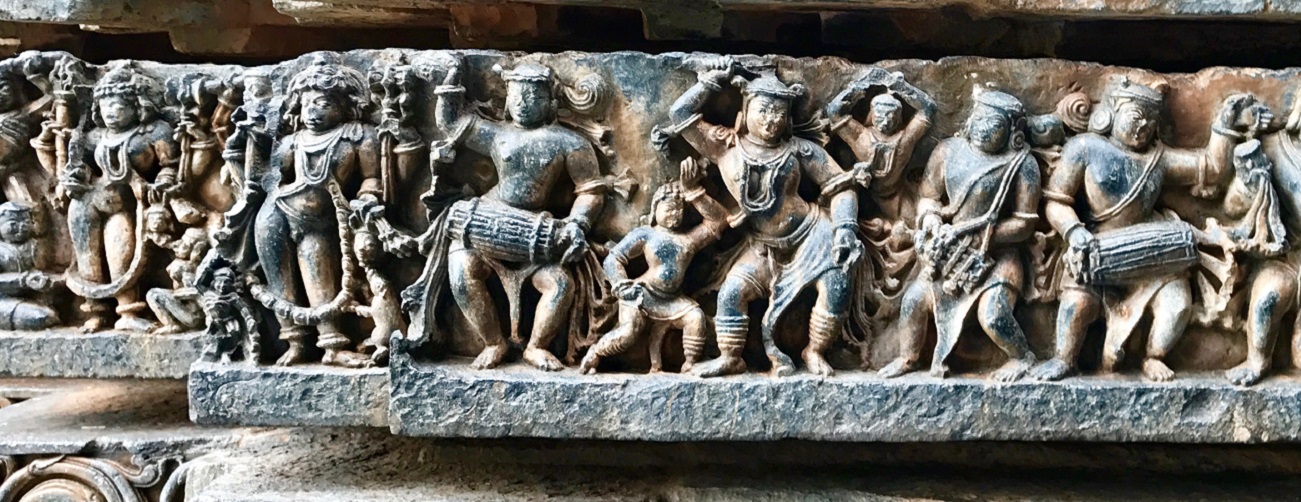Photo: Depiction of Music instruments in Sculptures at Hoysaleswara temple, Karnataka; Credit: Wikimedia
India, as one of the earliest cradles of civilization, has a long and glorious history of art and culture that spans longer than the history of most countries in existence today. Song and Dance in India is varied and diverse due to the many independent regional cultural traditions that make up the country as well as the many religious practices that boast thousands of different deities.
‘Sangeet‘ – music – defined by Indian Culture as a combination of Sam+Geet that means lyrics and speech. Sangeet includes 3 main aspects in its
- Vocal,
- Instrument &
- Dance.
The music of India includes Indian classical music, multiple varieties of folk, popular, pop, and, most recently, rock music.
History of Indian Music & Musical Instruments
Nature is the fountain source of all music. The beginning of Indian musicography is traced to Vedic chants that were sung during religious rituals performed by priests named Udgatar. The origin of musical composition is traced to the Vedic chant of Samveda (the Veda of music) created by Lord Brahma. In Vedic times music was the medium for prayer in religious ceremonies as well as entertainment and social occasions. The development of notes originated in the Vedic period itself.
There was a lot of influence of Mughals on Indian music over a period of time. They contributed a lot for Indian music.
India has a rich musical history with its very own musical instruments. Some music instruments are used primarily in North Indian music (Hindustani Sangeet), some are used in the south Indian music (Carnatic Sangeet), while others are found in folk music. The music of ancient India has its roots from the many indigenous instruments that gained wide use at the time such as the seven-holed flute and various stringed instruments. The oldest musical instrument of India is the Veena.
Photo: A Bin Player’; Photo Credit: Wikimedia

History of Indian classical music considers the following ancient treatise on the science of performing art
- The Natyashastra, written by the mythic priest Bharata
Different Musical Instruments
In the Natya Shastra musical instruments have been divided into four main categories on the basis of how sound is produced.
- The Tata Vadya or Chordophones- Stringed instruments – The instruments in which sound is produced by the vibrations in stretched metal wires are called string instruments e.g. sitar, violin, sarangi, sarod, tanupura/tambura etc.
- The Sushira Vadya or Aerophones- Wind instruments (Flute instruments & Reed instruments) – The instruments in which sound is produced by the vibrations in air column are called wind instruments e.g. flute, shehnai etc.
- The Avanaddha Vadya or Membranophones- Percussion instruments– The instruments in which sound is produced by the vibrations of a stretched skin are called percussion instruments e.g. tabla, dholak, mrindangam, drums etc.
- The Ghana Vadya or Idiophones- Solid instruments which do not require tuning and the earliest instruments invented by man e.g. Manjira, Khartal, Chimta, Morchang, Jaltarang, Ghatam.
We have shortlisted to describe only a few popular musical instruments which are integral parts of Indian Music..
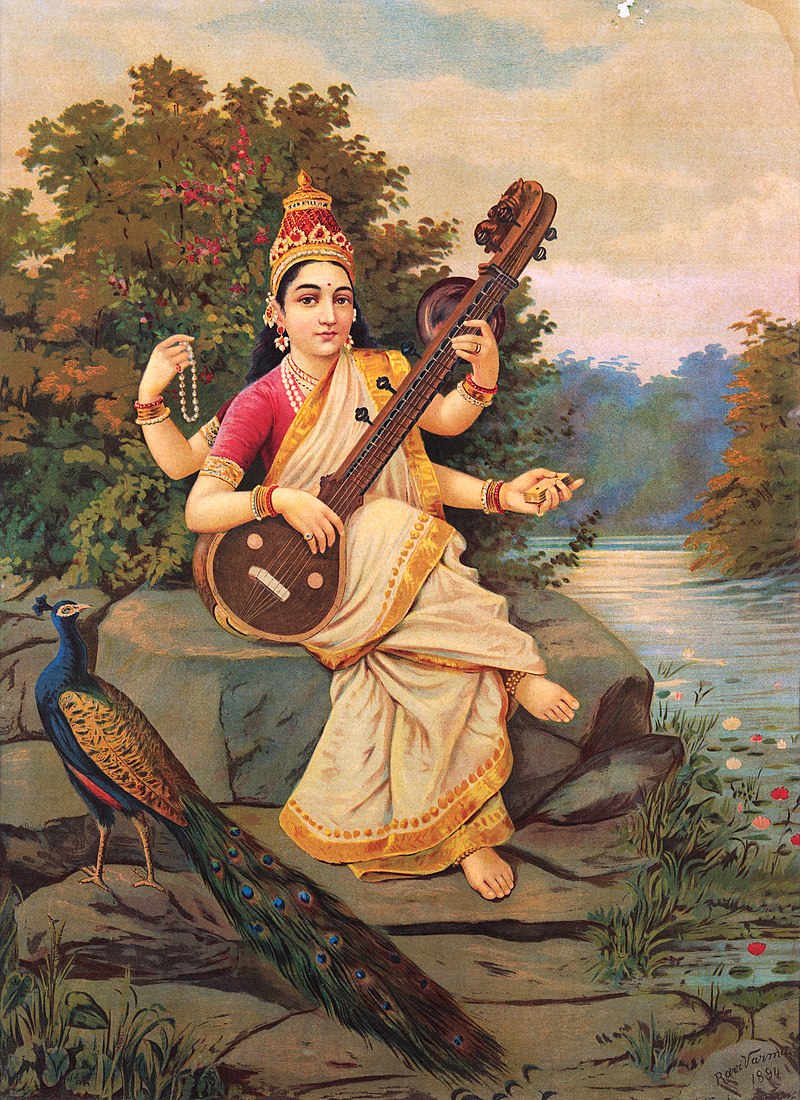
Saraswati Veena – Stringed Instrument
The Saraswati Veena, one of the most ancient Indian instruments, is a plucked stringed instrument used mainly in the south Indian – Carnatic classical musical. It is called “The Queen of Instruments” in the classical music of South India. The Saraswati Veena, whose origins date back to around 1700 BCE, occupies a place of pride among Indian musical instruments.
There are 4 types of Veena Instruments considered by scholars now-a-days and they are the Tanjavur (Saraswati) Veena, Rudra Veena, Vichitra Veena, and Gottuvadhyam (Chitra) Veena. Basically, it is mostly used in Carnatic Music, a form of South Indian Classical Music. The current form of the Saraswati Veena with 24 fixed frets evolved in Thanjavur, Tamil Nadu, during the reign of Raghunatha Nayak and it is for this reason sometimes called the Tanjore Veena or the Raghunatha Veena. The Saraswati Veena contains 4 lead strings to play the solo lead part of the music and 3 drone strings.
Listen to the Veena HERE.
Photo: Goddess Saraswati depicted playing the veena. Credit: Wikipedia.
Sitar- Stringed Instrument
The Sitar, one of the most ancient Indian instruments, is a plucked stringed instrument used mainly in Hindustani music – North Indian classical music. It is said to have been introduced in India in the thirteenth century by Amir Khusrau, the first great Muslim musicologist of India. The instrument’s name is derived from the Persian ‘setar’, or three-stringed. The influence of sitar can be largely seen towards the north side of India due to the Mughal dynasty impact. The captivating music from the strings of sitar has attracted many well known musical artists around the globe, musical bands like the Beatles and the Rolling Stones use sitar for their performance. The Sitar occupies a place of pride among Indian musical instruments. It is easily the most charming of all instruments.
Listen to the Sitar HERE.
Photo: Pandit Ravi Shankar, Sitar Player. Credit: Codeen
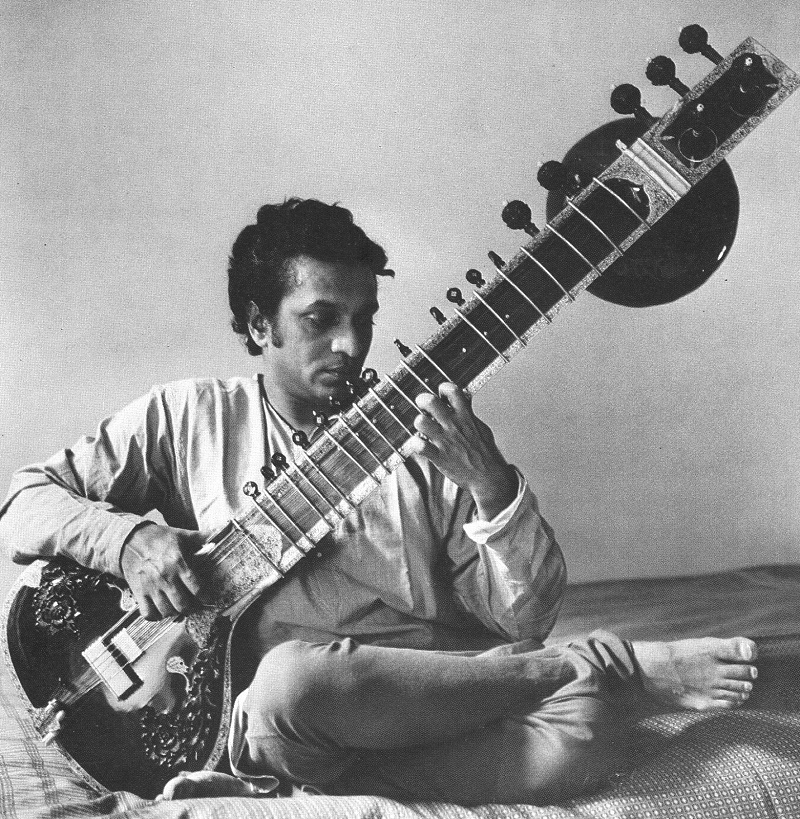
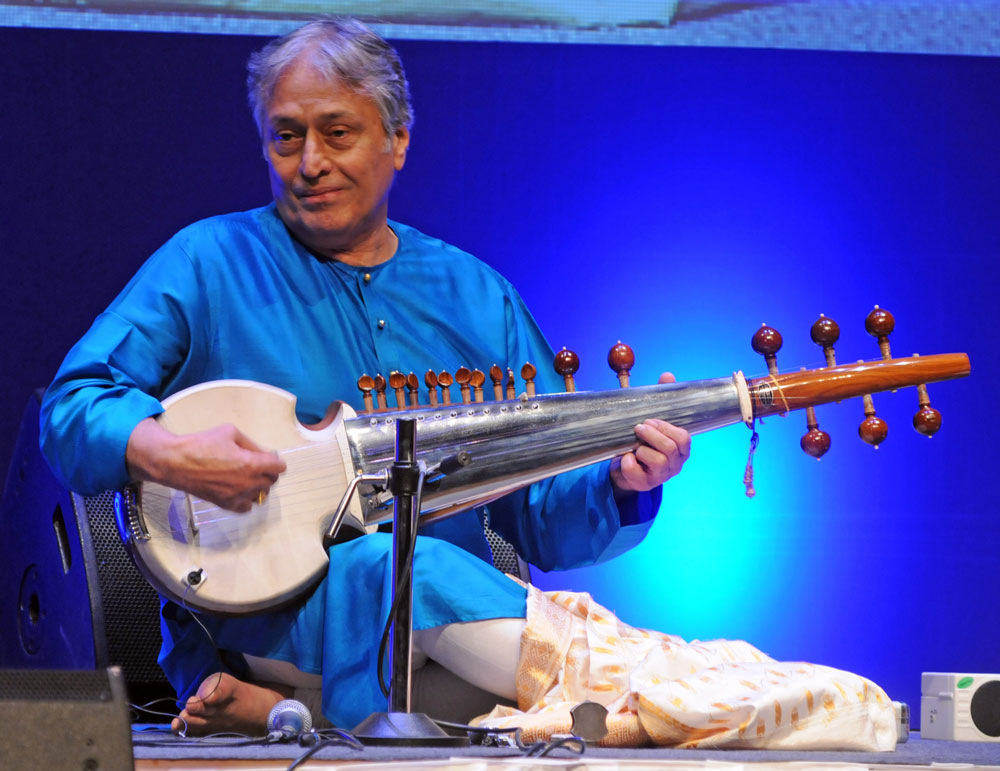
Sarod – Stringed Instrument
Sarod is a combination of the ancient Indian instruments veena and medieval rebab. Originating from the Rebab, a musical instrument of the Middle East, use of Sarod in Indian classical music can be traced back to the greatest musician ‘Tansen’. It is also said that Saheb Asadullah Khan began the use of Sarod as a musical instrument in Bengal in earlier days. Thereafter, Bengal became famous for manufacturing this musical instrument. Sarod is made of teak wood. This miniature musical instrument narrates the fascinating story of India’s musical heritage.
Listen to the Sarod HERE.
Photo: Ustad Amjad Ali Khan, Sarod Player. Credit: Deccan Herald.
Violin- Stringed Instrument
Violin is a four stringed instrument played with a bow. Violin plays a prominent role in carnatic music. Violin has been introduced to Carnatic music during the end of 18th century and start of 19th century. Violin became popular with the Carnatic parlance not only as the accompaniment, but also as a solo instrument. The ancestor of the Violin is believed to be the Ravanahatha, a folk instrument of Rajasthan, in India. Ravanahatha, is said to have originated during the time of Ravana, the mighty king of Lanka. According to mythology, Ravana was an ardent devotee of Lord Siva. He played on the Ravanhatta as a musical offering to the Lord. The violin has often been described as a musical bridge between Europe and India, as it is the only European instrument that has been successfully integrated into Indian classical music. Although the construction of the violin is the same in Indian and Western music, the tuning, playing posture, and techniques are quite different.
Listen to the Violin HERE.
Photo: Violinist Dr. L. Subramaniam. Credit: World Music Central
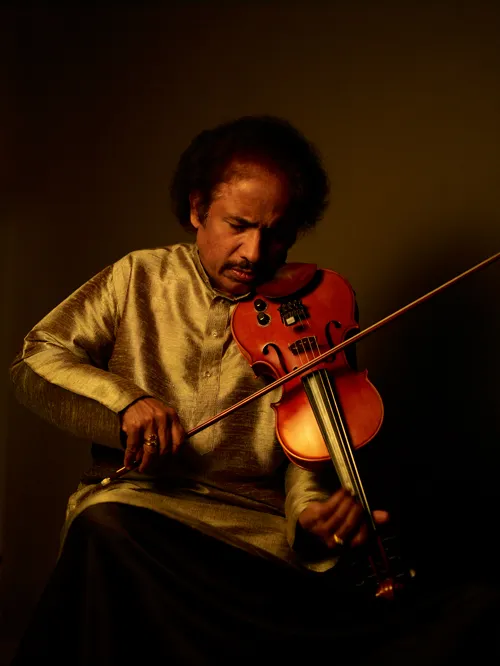
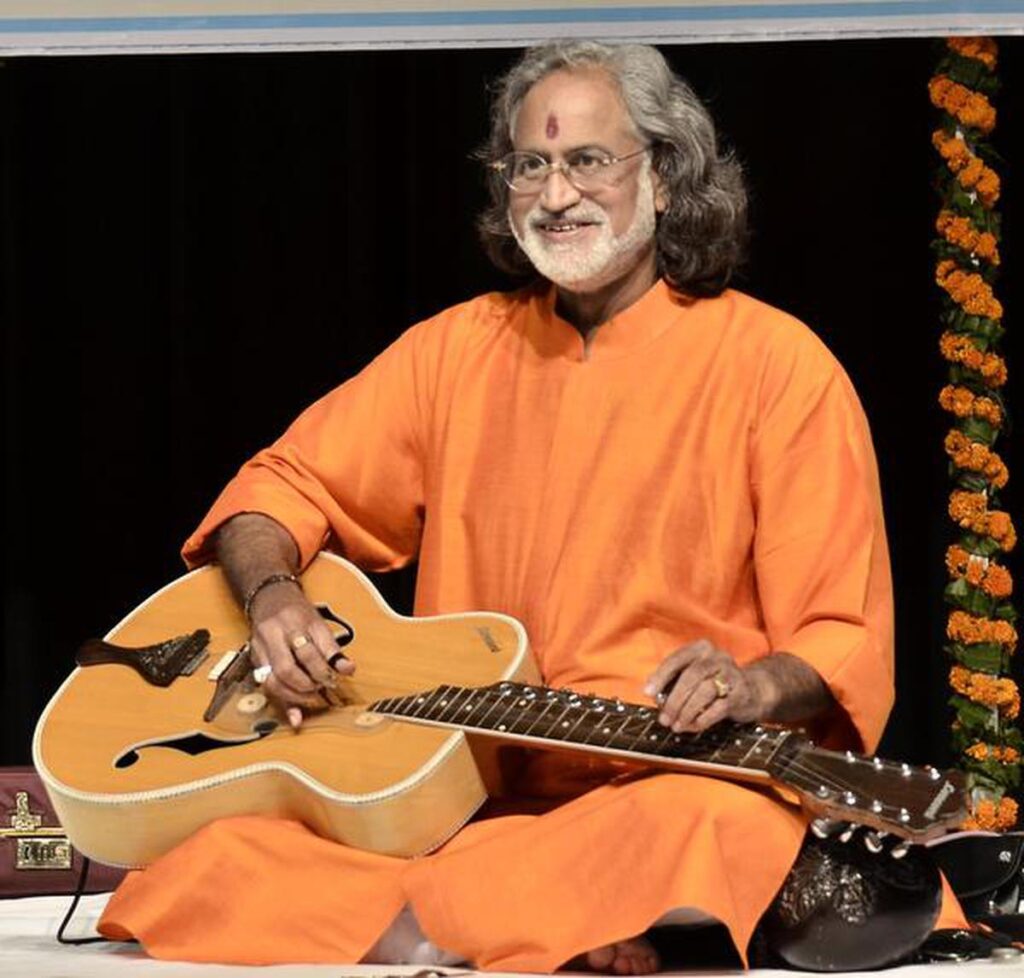
Guitar- Stringed Instrument
Most of the music exponents attribute the guitar as a western instrument but quite a few know that guitar was played in the ancient days in India during the Vedic period; the form of music was Samgan. The kachhapi veena was used in this period for solo performances and also as an accompanying instrument. This instrument later on is believed to have migrated to different parts of the world and acquired different names while it vanished from India. The classical gut-string guitar appeared in the musical circles in Madras around the 1840s. The steel string guitar has gained popularity in the North-East region of India and Goa and become mainstream Indian instruments in popular settings and have also occasionally been incorporated in Indian classical music, ghazals and other so-called “light music” forms in India. Acoustic guitars have 6 strings and are great for beginners as they are simple and easy to use.
Photo: Pandit Vishwa Mohan Bhatt – a Mohan Veena player. Mohan Veena – a modified version of slide guitar (a technique for playing the guitar that is often used in blues music.) player; Credit: The Hindu.
Listen to the Indian slide guitar HERE.
Dugi Tabla – Percussion Instrument
Dugi Tabla is an important rhythmic accompaniment to vocal, instrument and dance performances. Dugi Tabla – a percussion instrument which consists of a pair of single headed drums – Dugi/Bayan or the larger drum and Tabla/Dayan or the smaller drum. As an instrument of Indian heritage, Dugi Tabla has great importance in accompanying vocals and other types of instruments. There are many theories regarding the invention of the Tabla. The first assumption was that it was discovered by a drummer named Amir Khusru in the first half of the 18th century. The second assumption is connected with the Indian mythology which told that Lord Ganesh once while playing the parental Indian instrument pakhavaj, accidentally dropped it and that’s how the partition gave us Tabla. Tabla also has a great deal of importance in the accompaniment of dance. There are various Indian traditional dance forms such as Bharatanatyam, Kathak, Odissi, and many other south Indian dances. In all these dance forms, especially in North Indian dance Kathak, the tabla is popularly used for accompaniment. In vocals too, the tabla is used in showing the tala to the singer.
Listen to the Tabla HERE.
Photo: Ustad Alla Rakha, Percussionist. Credit: Wikipedia


Dholak- Percussion Instrument
Dholak – A two-headed hand drum, Dholak is a folk percussion instrument. The dholak is the most commonly played musical instrument in Northern India. Dholak can be played in three ways- on the player’s lap, while standing, or pressed down with one knee while sitting on the floor. It appears to be in barrel shape with simple skin covering on the right and left hand sides. The instrument is widely used at the Lavani – a traditional song and dance form of Maharashtra, Punjabi folkloric dance music called bhangra and other dance forms in India. The high pitch rhythm that is produced makes people experience an enthusiastic level and everybody would want to perform to the rhythm. In northern parts of India it becomes a must use instrument at occasions such as sangeet, traditional events and other singing competitions.
Listen to the Dholak HERE.
Photo: Dholak Maestro Pt.Navin Sharma, Photo Credit: SARB AKAL TV.
Harmonium – Wind Instrument – Reed Instrument
Harmonium, a keyboard musical instrument, is often used as an accompanying instrument by vocalists. During the mid-19th century missionaries brought French-made hand-pumped harmoniums to India. Though derived from the designs developed in France, the harmonium was developed further in India in unique ways, such as the addition of drone stops and a scale changing mechanism. It is extensively used to accompany folk, classical, Sufi, and ghazal compositions for both music and dance. The harmonium is also commonly accompanied by the Tabla.
Listen to Vidushi Kishori Amonkar sings playing harmonium HERE.
Photo: Vidushi Kishori Amonkar using Harmonium. Credit: The Guardian
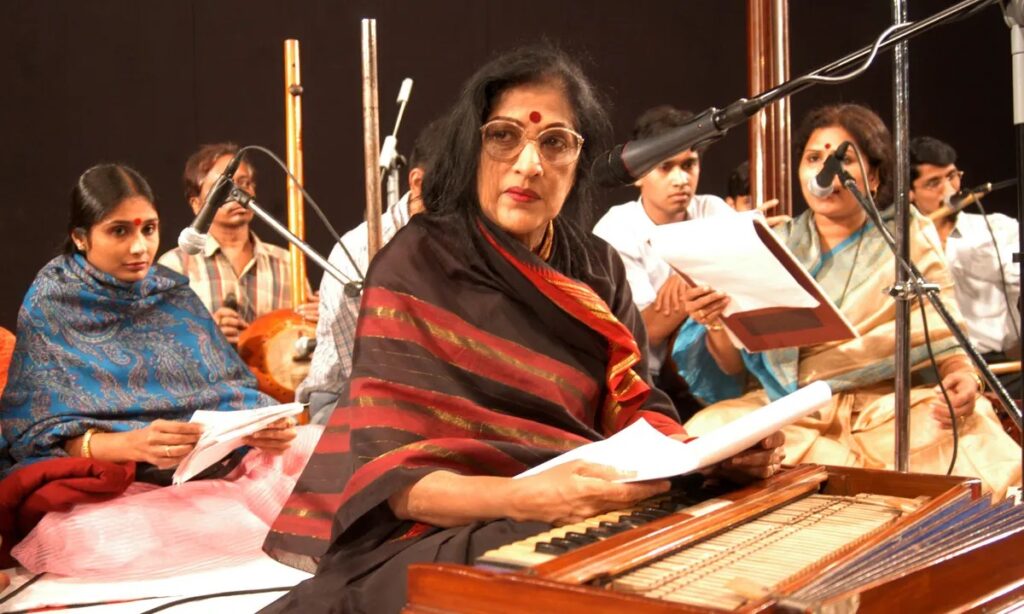
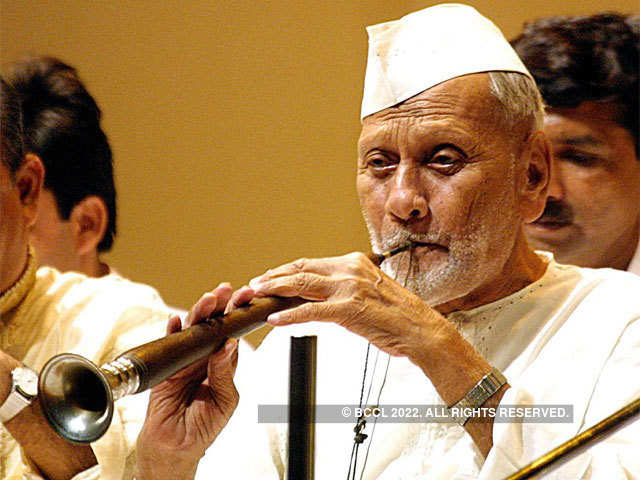
Shehnai – Wind Instrument – Reed Instrument
The Shehnai is a reed instrument in which there are seven holes along the tube which are used for playing the melody by opening and closing them with the fingers. In the past, the Shehnai was part of the naubat (traditional ensemble of nine instruments found at royal courts). It is known as a Mangal vadya and is usually played on all auspicious occasions in north India such as marriages, temple festivals, etc.
Listen to the Shehnai HERE.
Photo: Shehnai Player, Ustad Bismillah Khan. Credit: The Economic Times
Bansuri – Wind Instrument– Flute Instrument
Single or double flutes with only one hollow tube with finger holes for controlling the pitch of the note are very common in many parts of the country. The flute has a variety of names like Venu, Vamsi, Bansuri, Murali and so on in the north, and Pullankuzhal, Pillankarovi and Kolalu in the south. The bansuri ( bans [bamboo] + swar [a musical note] ) is a transverse alto flute made of a single length of bamboo and has six or seven open finger holes. The bansuri is revered as Lord Krishna’s divine instrument and is often associated with Krishna’s Rasa lila dance.
Listen to the Bansuri HERE.
Photo: Flautist of India, Pandit Hariprasad Chaurasia . Credit: The Economic Times
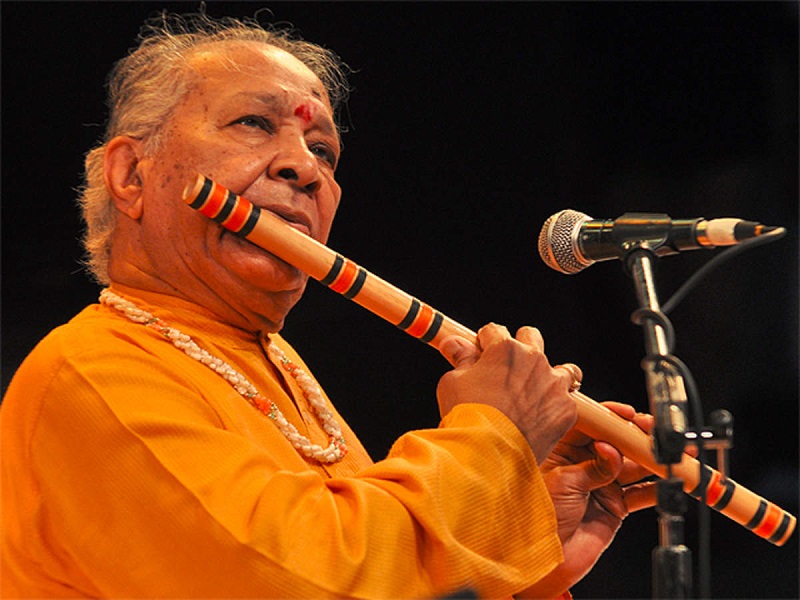
Music Souvenirs
We have the gift ideas to suit every music lover’s groove. Our Indian Music collection consists of products which represent different aspects of Indian classical music. & narrate the fascinating story of India’s music heritage.
- Music instruments miniatures,
- Music trophy/awards,
- Medallions,
- Music souvenirs like mugs,
- posters,
- prints
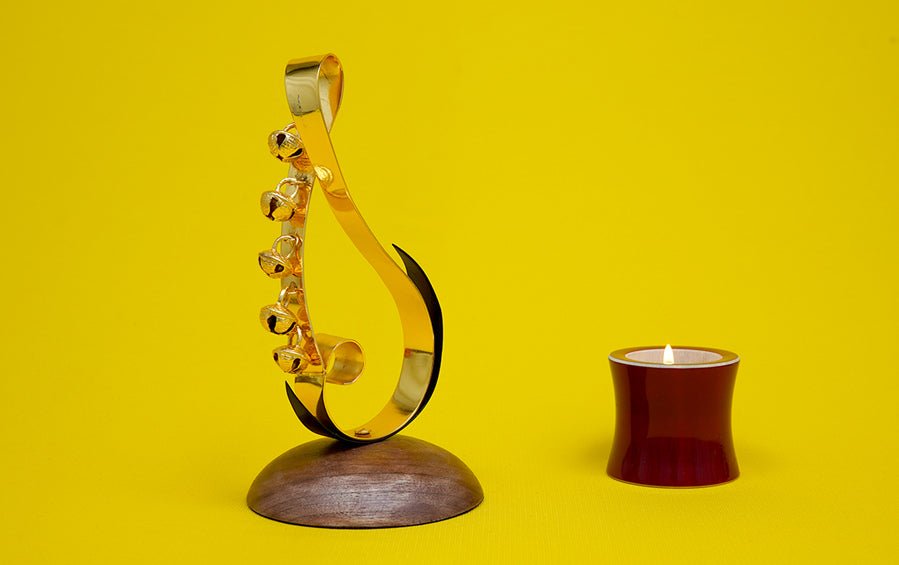
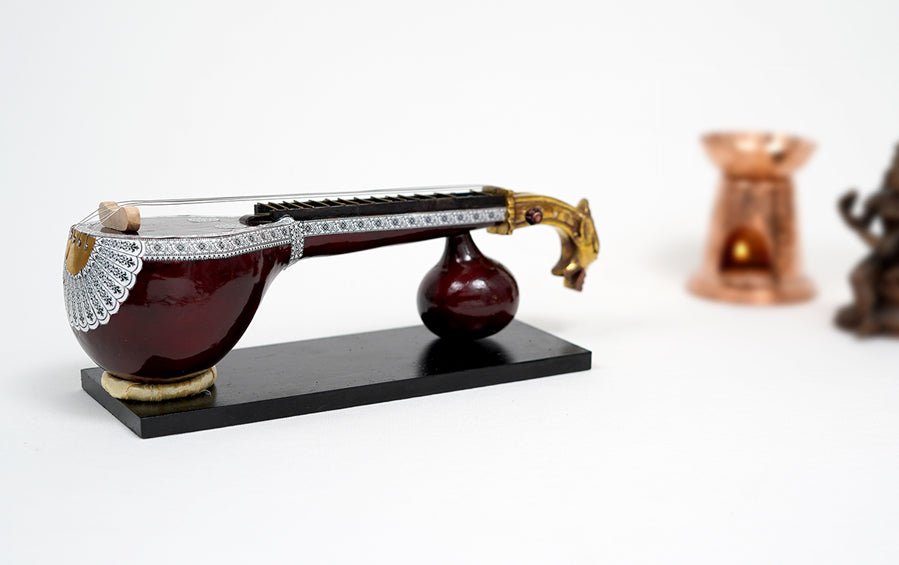
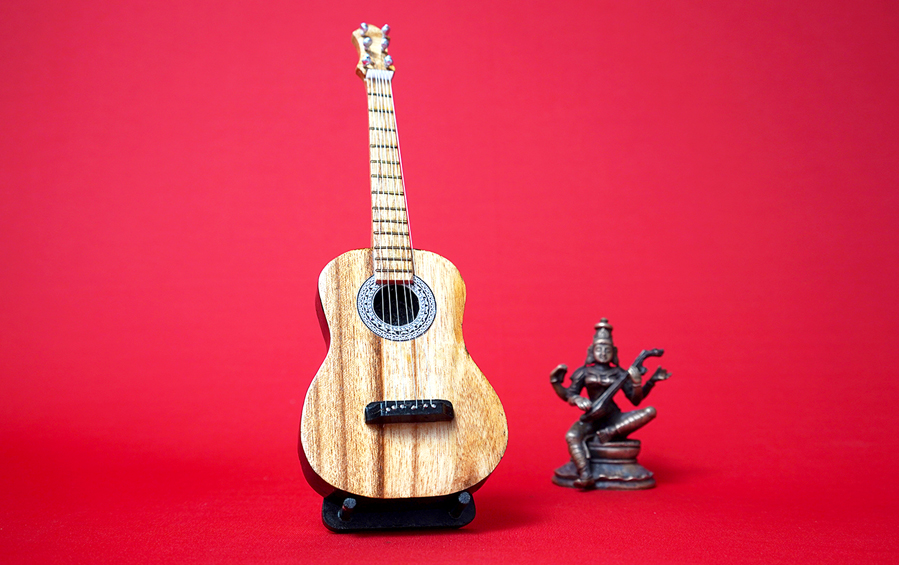
Source:
- Musical Instruments, Centre for Cultural Resources and Training (CCRT). Retrieved from http://ccrtindia.gov.in/musical-instruments/
- Thanjavur Veena to be first Indian instrument to get ‘made in Thanjavur’ tag, First Post. Retrieved from https://www.firstpost.com/living/thanjavur-veena-to-be-first-indian-instrument-to-get-made-in-thanjavur-tag-545793.html
- Music of India : Musical Instruments : Sarod. Indobase.com. Retrieved from http://music.indobase.com/musical-instruments/sarod.html
- Carnatic Violin, Swararnava.com, Retrieved from https://swararnava.com/carnatic-violin/
- Strings attached: A short history of the Western classical guitar in India, Music History, Scroll.in, Retrieved from https://scroll.in/magazine/842217/strings-attached-a-short-history-of-the-western-classical-guitar-in-india
- Origin of Tabla and its importance, Dated 10 August, 2021, Bennett Coleman and Co. Ltd. (Times Group), Times of India. Retrieved from https://timesofindia.indiatimes.com/readersblog/study-of-the-tabla/origin-of-tabla-and-its-importance-36205/


